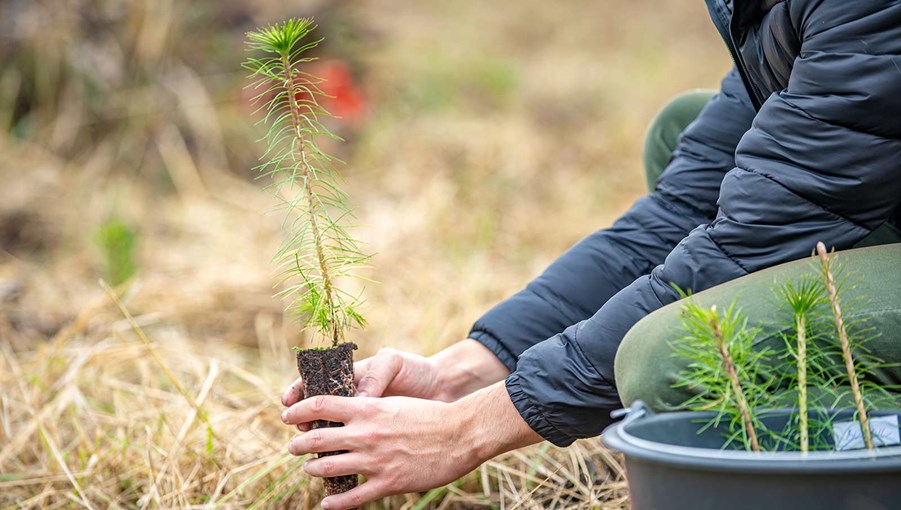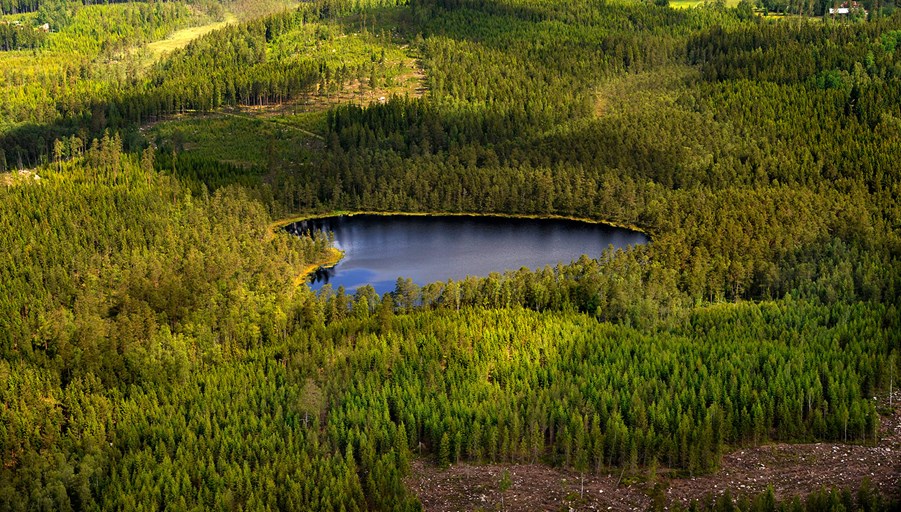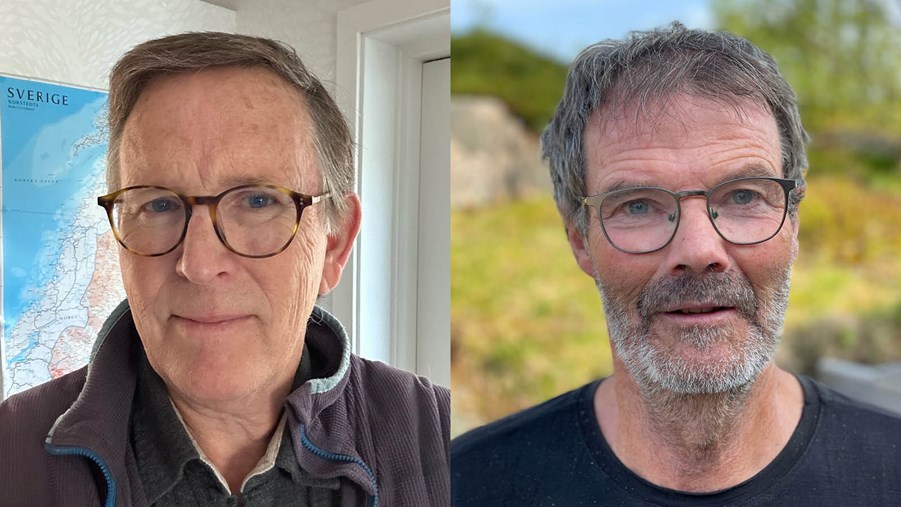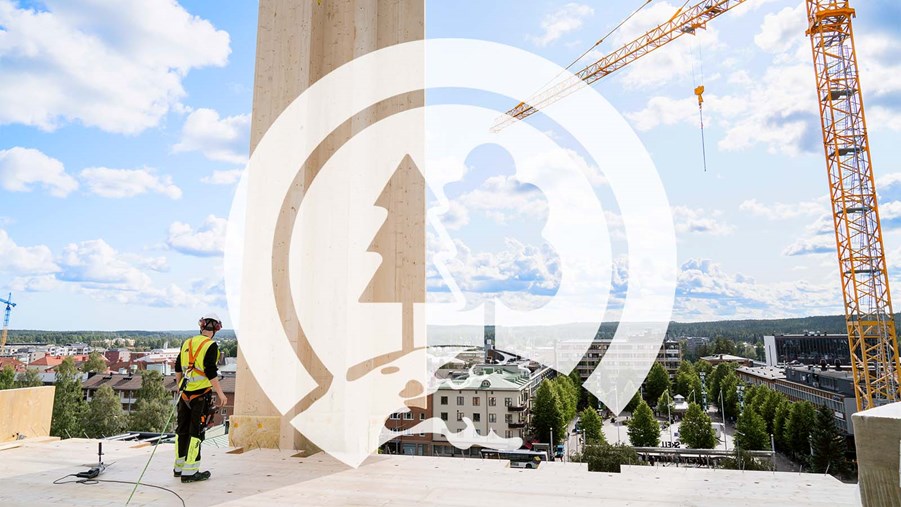
How much of Sweden’s forests are managed?
40.7 million hectares – that’s how large Sweden’s surface area is. And 70 per cent of that currently consists of forest; and around 75 per cent of that is managed long-term. Forests are therefore one of Sweden’s most important renewable sources of raw materials. It takes between 60 and 120 years for a tree to become fully grown so it can be harvested. When an area of forest is felled, an average of 11 per cent is left untouched for so-called “general consideration”.
Twenty-five per cent of Swedish woodland is excluded from forestry activity due to various reasons such as environmental considerations or because land is unproductive. Nine per cent of Sweden’s woodland has formal protection as nature reserves.
How do forestry industries use the green cycle?
Growing trees absorb and bind carbon dioxide. Carbon is also stored in the products we make from trees, such as houses, furniture, packaging, paper and textiles. These are important products in people’s daily lives and they have a vital role in the transition from fossil fuels to renewables.
Wood fibre can be recycled many times. When it can no longer be recycled, it can be used, together with residual products from forestry and forest industry activity, as green bioenergy for heating, electricity and fuel. When bioenergy is burned, biogenic carbon dioxide is formed, which is reabsorbed by growing trees, thus completing the cycle. In Sweden, we plant at least two trees for every tree we harvest.
What is sustainable forestry?
“Sustainable forestry is the management and use of forests and woodland in such a way, and at such a rate, that its biological diversity, productivity, regeneration capacity, vitality and ability to fulfil important ecological, economic and social functions now and in the future and at the national and global level is preserved, without harming other ecosystems.”
This definition of sustainable forestry is supported by the UN’s Food and Agricultural Agency and the pan-European high-level forestry process, Forest Europe. The definition is based on Agenda 2030, which also forms the basis for the development of sustainable forestry in Sweden.
What is the current state of biodiversity in Sweden’s forests?
Biodiversity is necessary for resilient and healthy forests that are well prepared for climate change and increasingly extreme weather conditions. Forest industries are based on the idea that forests should be used in ways that increase both growth and biodiversity.
Conditions for biodiversity in Sweden’s forests have improved over the past 30 years. For example, the amount of deadwood and the proportion of old forest has increased by 80 per cent on land where forestry is conducted. Furthermore, the amount of coarse hardwoods has tripled.
Are there forest plantations in Sweden?
Plantation forestry is often associated with intensively managed forests, extremely short rotation times and trees planted in straight lines. Areas of young forest planted in Sweden can also look like this, to the extent that the type of trees planted determines how forests look in their first years of growth. However, the rotation period at our latitudes is lengthy. Our forests grow slowly, often involving cycles of between 60 and 120 years, depending on where in the country you are. During this period, and usually already after one or a few years, many self-sown trees of different tree species and other species flourish, resulting in more biodiverse forests.
At harvesting, many trees and areas are also left untouched to become part of the new stand and contribute to imbuing new forests with key characteristics of older trees. Clearing trees can create varied environments with undergrowth, smaller groups of trees, older trees, dead trees and edge zones. The availability of substrate for insects is often especially high in clearings in the first five to 10 years after felling.
So, even if planted forests in Sweden in their early years bare some resemblance to plantation forests, this is not plantation forestry according to the accepted definition.
How much old forest do we have in Sweden?
Older forest environments are important. Many rare species live only in such areas. The Swedish National Forestry Inventory’s measurements of old forest, defined as forest with an average age of more than 140 years in northern Sweden and 120 years in the south of the country, indicate that this type of forest became less prevalent during the 20th century, and reached its lowest point in the early 1990s at approximately one million hectares. But the trend has reversed since then, and the proportion of old forest has increased by 80 per cent. The Swedish forestry model, first introduced in 1994 and which puts equal importance on environmental and production goals, has begun to take effect.
What is continuity forest?
Continuity forest refers to areas that have experienced tree growth for extended periods and have never been fully felled. Neither do such areas undergo significant changes in tree species, with the same tree species growing for at least two normal rotation periods. In practice, this often means that an older forest today would have already existed in the 1950s. Continuity forests may have been affected by humans, for example through forest grazing or clear-cutting, but have always been more or less wooded.
Does continuity forest always have high nature values?
Historically, continuity forest may have been dimension felled, (when only trees exceeding a certain diameter are felled), thinned, felled or fertilized and still have unbroken continuity and therefore still be classified as continuity forest. Continuity forests often have high nature values, although this is not necessarily the case. They may be cultivated in such a way that they lack old trees, deadwood and threatened species even if it has never been cleared.
What distinguishes continuity forest from ordinary managed production forest?
Continuity forest has never been cleared, (although may have been heavily logged), and may be home to species that are sensitive to clear-cutting and land preparation. This particularly applies to certain mycorrhizal fungi that live in symbiosis with tree roots.
A planted production forest is a forest that has been planted after felling, and thus trees in such areas are approximately the same age, with the exception of trees in “consideration” areas that are allowed to grow into new forest. Land in these areas has sometimes been previously used for other purposes such as agriculture.
How much continuity forest is there in Sweden, and where is it?
It depends on which definition is used, with estimates ranging from 1.8 million to 6 million hectares.
Continuity forests are found all over Sweden but are especially common in the northwest of the country. This is because tract logging was introduced later in the northwest and that forestry has been less intensive here. This has meant that many continuity forests are part of nature reserves, national parks or have been set aside voluntarily by forest owners.
Is it permitted to fell continuity forests?
The concept of continuity forest is not used in Swedish forest legislation and there is no explicit ban on felling in such areas.
It is not illegal to fell in this type of forest as long as the area is not protected – and although a given continuity forest may have high nature values, this is not always the case. This means that wood from continuity forests is used.
It is down to forest owners to decide how they want to use their forest based on existing legislation.
Can forestry be described as sustainable even if felling takes place in continuity forests?
Yes. Sustainable forestry is forestry that aligns with international principles of sustainable development. This means forestry that is economically, ecologically, and socially sustainable over the long term. Sustainable forestry is not only about measures taken with specific stocks, but it must also be conducted and planned at landscape level. For all felling, different natural values need to be taken into account, while certain areas are completely excluded from harvesting.
Some continuity forests have high natural values. In such areas, responsible logging-free forestry methods can enable timber production, or there may be reasons to completely exempt the area from forestry. But there are also continuity forests that have no major nature values, enabling them to be used in line with sustainable forestry.
What are “old-growth forests”?
Old-growth forest is not the same as continuity forest or old forests, i.e. a forest above a certain age, neither should it be translated into the broader term "natural forest". Rather, it refers to a concept for really old forests that should contain certain characteristics and be similar to an undisturbed forest, according to the EU Commission. Forests that are under productive management are not included in the concept.
The concept has recently been introduced into EU legislation (the Renewable Energy Directive) and strategies. In Sweden, the Old-growth forest concept does not exist as a concept in legislation and there is no established definition. Therefore, the Swedish government has asked the Swedish Forest Agency to develop a clear definition and criteria for old-growth forests from a Swedish perspective. The Swedish Forest Agency must submit its proposals, including a definition of old-growth forest, to Sweden’s Ministry of Rural Development and Infrastructure by 31 August 2024.
Since the concept has been introduced in legislation, it needs a clear interpretation for the Swedish context that can function in legal application in a legally secure way. It is of utmost importance that the definitions are clear, with objective and measurable indicators and quality requirements to ensure legal certainty.


